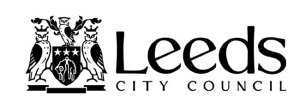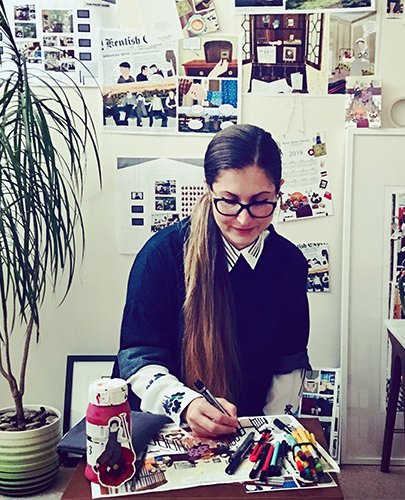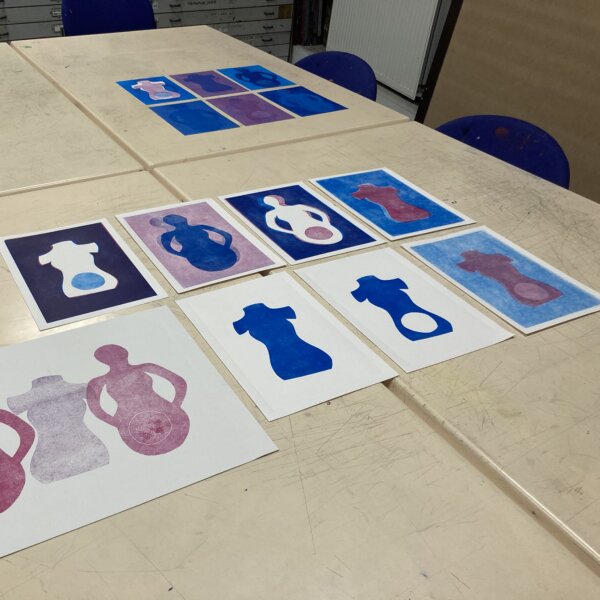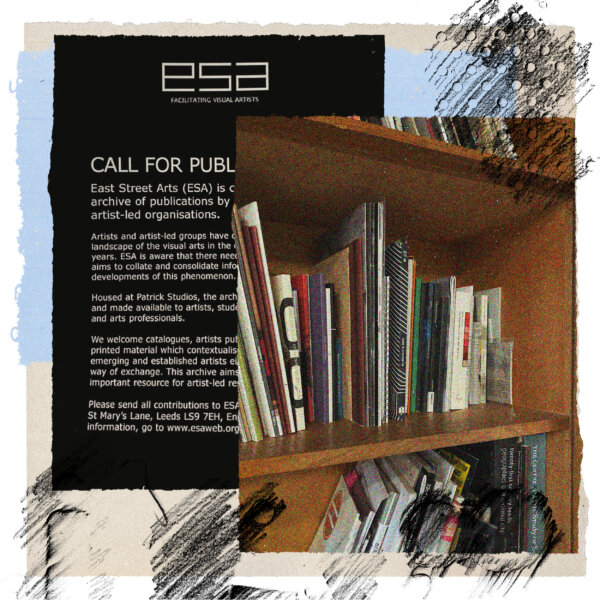Our streets, and the buildings sat on them, have myriad untold tales from our past, with glimpses of the vibrant lives lived and the activities that went on.
The Leeds areas of Burmantofts and New Briggate have more than their fair share and recently East Street Arts with artists Kremena Dimitrova and Rosie Todd started work on the exciting ‘Untold Stories of Burmantofts and New Briggate’ to uncover and share the tales from these streets.
Alongside volunteer Robert Dyson from Leeds Civic Trust, Kremena delved into the fascinating history of Burmantofts Pottery and its relationship to the High Street in Leeds City Centre; New Briggate.
For 99 years between 1859 and 1958 Burmantofts Pottery was an internationally renowned producer of ceramics, including their bullfrog and toad teaspoon warmers, which were one of the most interesting finds from the project. The Pottery came to an end when a wave of cheaper mimics flooded the market and they could no longer sustain their high-end manufacturing.
The Pottery sits at the heart of a diverse history in the urban neighbourhoods of East Leeds (Burmantofts, Lincoln Green and Mabgate) and its untold stories of earth, clay, industry and migration, as well as vibrant everyday life.
Also working with participating groups MAFWA Theatre, Burmantofts Senior Action and Shakespeare Primary School, this project has actively connected the past with the current community.
As the project drew to a close, we spoke to Kremena and Rosie about the project, it’s challenges during lockdown and its legacy.
What drew you to working on this project?
Rosie: I grew up in Leeds and even lived in Burmantofts for a while but it was only really when I lived in Edinburgh to study ceramics that I realised how deeply Burmantofts Pottery ran through the fabric of the city and gave it a really distinctive identity. So much of our public space is given its flavour by Burmantofts and I was fascinated by this and also by how the export of Burmantofts means that all over the world places are built out of a little bit of Leeds earth.
Kremena: There were many similarities between my creative career and academic research and the Untold Stories of Burmantofts and New Briggate pilot project. This project and I were the perfect fit. As an illustrator-as-historian, storyteller, lecturer, and researcher, I specialise in visualising history in the museum and heritage sectors with a focus on bringing to light untold, hidden, and side-lined histories.
My creative practice is also socially engaged in nature. Apart from the historical research and creative side of the project, I was drawn to the collaborative and co-created feel of the project as well to its open-endedness. There were no preconceived outcomes. I could develop anything I wanted together with and inspired by the communities I worked with. I liked that the project was intergenerational – working with very different communities, which meant I had to wear different creative hats each time I was in contact with them.
What has been the biggest challenge you’ve faced during the project?
Rosie: Without a doubt delivering the community aspects in various degrees of lockdown. Though we have worked hard to be innovative and flexible and make what we have done as accessible as possible I have really missed gathering together with people to chat and make.
Kremena: Working on the project remotely and not being able to travel to and be in Leeds. Although this has not affected the delivery of the project from a research/creative point of view.
In fact, because of lockdown I was able to spend much more time researching, thinking, and making, as opposed to if I’d had to travel to Leeds on a regular basis. This being said, I would have liked to visit the buildings that feature Burmantofts faience and engage in observational location drawing or guide an archaeological dig with pupils from Shakespeare Primary School, for example. I instead imagined the above and included many of my ideas in the final resource which I developed for the project (an illustrated history book in rhymes).
How did you work together to share ideas? Especially with the restrictions of Covid, did this cause any issues?
Kremena: We had regular weekly zoom meetings which were very useful, and which I very much looked forward to. I found the sessions very creative as we could plan, discuss, give feedback, and share ideas with East Street Arts and the artist-educator.
We also regularly corresponded via email and over the phone. We had regular contact with the communities and especially with Burmantofts Senior Action members to gather untold stories and memories. I do not think that these sessions would have necessarily benefited more from a face-to-face interaction. As a mixed media digital illustrator, I am used to working, creating, delivering projects, and teaching from home.
How did your work change/adapt throughout the project?
Rosie: As well as continually changing the methods of workshop delivery (postal, Zoom, video, phone calls etc) distance working meant that we were reliant upon participants not only taking part but returning work to us by post so we could include it in the final piece. As such I had to be really flexible about the design of the final piece right till the end when we knew what work we’d be able to use. It was a really lovely surprise that we had so many tiles made by participants sent back and the challenge was making room for as many as possible in the end!
Kremena: I personally think that the project was more creative because of lockdown. We had to adapt, be flexible, think outside the box in order to meet the aims and objectives of the project. We had to think about and devise different approaches to deliver the project and the workshops with the three different communities making sure that the workshops fitted with their needs.
With Burmantofts Senior Action we engaged through the post and over the phone. With Shakespeare Primary School through the post and through pre-recorded history-telling and creative sessions, and with MAFWA Theatre we delivered workshops over Zoom.
Have you developed any new skills from taking part in this project?
Rosie: Zoom delivery,and indeed distance delivery in general, has definitely been a learning curve! I’ve lots of experience of putting together kits and instructions but have learnt so much about why people get involved in community arts projects and mostly, it’s for the community and not as much for the art!
Kremena: I developed, wrote, designed, and illustrated a collaborative (hi)story book in rhymes co-created with the community groups’ memories, ideas, suggestions, and creative outcomes from workshops. I hadn’t written any stories in rhymes before working on the Untold Stories of Burmantofts and New Briggate project.
This new approach was mainly down to the fact that the communities we were working with were interested in poetry and storytelling more than they were interested in art. With their help and being inspired by their thinking and ideas, I decided to explore new creative territories. I pleasantly surprised myself and I plan to continue to creatively progress my newfound love for poetry. I hope the communities enjoy our collaborative and co-created history book in rhymes.
Are there any aspects of this project that you wish you could have investigated further if you had the time?
Rosie: Oh gosh yes lots! There are so many threads of social history uncovered that we just didn’t get chance to get to grips with. Some may be apocryphal (the pottery being marked on secret German ww2 maps?) Others are entire projects in themselves (the studio 20 Jazz club, the 1888 directory of business on new Briggate!). I’d love to make a map of Burmantofts buildings and really investigate the site where the pottery stood. It’s all just time!
Kremena: When it comes down to history and heritage, there is always something more to do, learn about, and discover. The possibilities are endless, especially in terms of creatively engaging with history and heritage. I would have liked to spend more time looking into the First World War period and how it affected the pottery/production. I would have researched in more detail the different artists who worked at the pottery. In terms of oral histories, I would have looked into/contacted people around the world who have Burmantofts in their private collections.
Are you happy with the final pieces you’ve created from this project?
Rosie: Really pleased with the idea I came up with and how it pulled together various aspects of the project, the history and narratives and participants’ work, it would have been lovely to have worked more with participants to explore clay and stories more. In covid times we didn’t have a set end destination for the final piece so it needed to be flexible in terms of display which is totally fine but it’s often better if it can be built into a space where possible but hey, that’s the nature of the times we are in!
Kremena: Together with the communities we co-created a body of work that people can admire but also learn from, remember, use. The illustrated Untold Stories of Burmantofts and New Briggate history book in rhymes is historically accurate and nostalgic as well as contemporary and forward-looking. It is accessible (as an online and physical resource), inclusive, memorable. It leaves a legacy as something that can be enjoyed, read, seen, narrated, listened to, used, performed, played with, treasured by everyone. The book will be published by East Street Arts in the Spring of 2021.
What do you hope the legacy of this project will be?
Rosie: Though the project feels complete in itself it also brought to light how much fascinating history lies below the surface of Burmantofts and New Briggate and what rich seams of creative investigation there are there! I really hope this is the starting point for further investigation of the area and particularly the pottery!
Kremena: One of the legacies is that on completion of the project people know a little more about the Burmantofts pottery and can remember it, be proud of it, and tell its stories. The legacy is that communities were involved in the delivery of the project and together we co-created the illustrated history book in rhymes inspired by the Untold Stories of Burmantofts and New Briggate project. The communities had a say in what to focus on and what stories they deemed important and worth telling and in what ways. Together we created a body of work that people can admire but also learn from, remember, use. A body of work which is memorable, educational and which has more than just an aesthetic purpose – it can make people think about/reflect on the past and their heritage. Hopefully by being involved in this project, people will see/think about Leeds in new ways.
The project leaves a legacy in that it brought people together when they most needed it – during lockdown and the difficult Covid-19 period. We used creative means to bring history to life and maintained connectivity between people who would not otherwise have been able to interact. This connectivity, I believe, was very helpful and needed during the Covid-19 period and appreciated by all of us.
Many people from around the world worked at the Burmantofts pottery. Post Brexit is a good time as ever to communicate positive messages about migration which very much relates to the pottery. This project reminds how migrant communities have always contributed to Britain’s development. We are a multicultural society we should be proud of.
Discover more about the project HERE
To mark the end of the project, Kremena created a children’s book from her research findings, which is visible below.


Other things!
-
News
Artist-Led Housing: Histories, Residencies, Spaces - available to buy!
Architectural researcher Dr Jonathan Orlek's brand-new publication, Artist-Led Housing: Histories, Residencies, Spaces is now available to buy.
-
News
Taipei Residency: Artist Call Out
Are you an artist using sound and audio-visual media at the core of your practice? Do you want to collaborate with communities and other artists to develop new artworks? Apply now! Deadline 12pm, Sunday 5 May 2024.
-
News
Leeds Creative Labs Follow on Fund: Herfa Martina Thompson Dr Zoe Tongue
Visual artist Herfa Martina Thompson and Law lecturer Dr Zoe Tongue first collaborated as part of Leeds Creative Labs, a programme that partners artists and academics, initiated by the University of Leeds’ Cultural Institute and facilitated in partnership with East Street Arts.
-
History
Listen to the Sounds of New Briggate
Sounds of New Briggate is our podcast series - hosted by local people, telling local stories - which celebrates New Briggate, a unique and vibrant high street in the heart of Leeds.
-
News
Artist Mohammad Barrangi’s large-scale murals come to the streets of Leeds
We're working with Leeds-based, Iranian-born illustrator and printmaker Mohammad Barrangi to bring three large-scale paper murals to the streets of Leeds.
-
Artist support
Submit your publications to our exhibition and learning library
Do you make books or printed materials on artist-led housing, live/work spaces, civic practice or living archives? Contribute now! Together we can learn.








